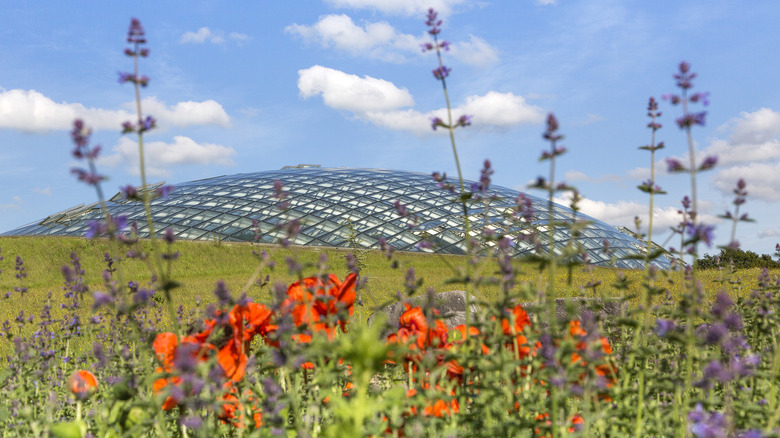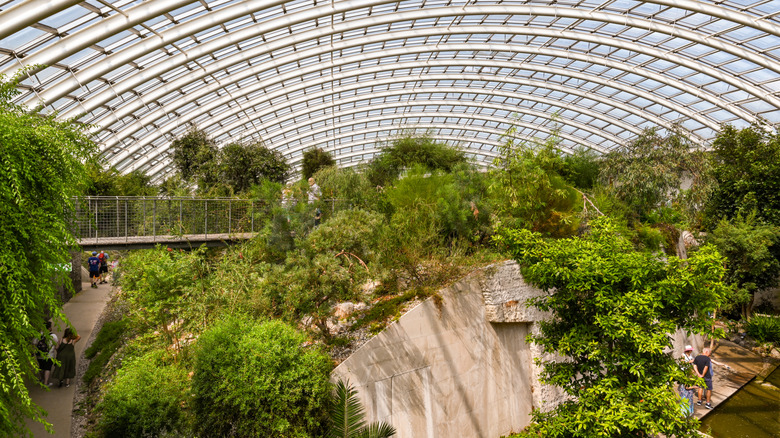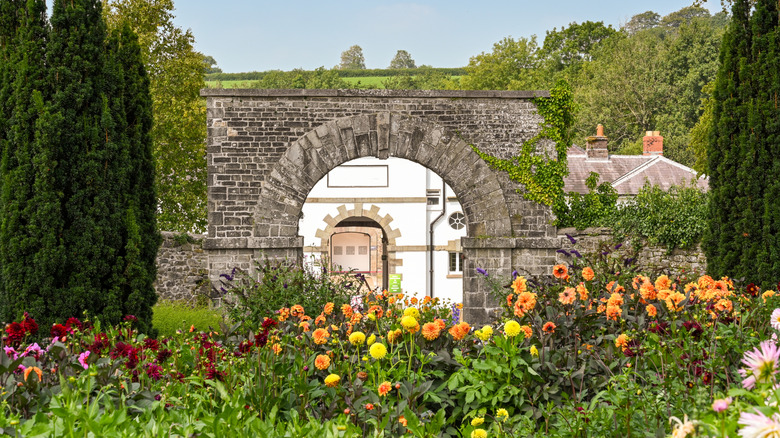The World's Largest Single-Span Glasshouse Is A Wildly Impressive Garden And Park In Wales
To many, Wales may be the lesser-known country on the island of Great Britain (the more well-known ones being England and Scotland), but it's anything but forgettable. With its rugged mountains, medieval castles, and endless walking paths surrounding this underrated European country's entire breathtaking coastline, Wales offers some of the most awe-inspiring wild landscapes and ruins. It also has a deep connection to nature and conservation. Set in the rolling countryside of Carmarthenshire is the National Botanic Garden of Wales — both a scientific hub and a scenic escape.
Every botanic garden has a defining feature, and here, it's the Great Glasshouse. This enormous, curved structure holds the title of the world's largest single-span glasshouse, approximately measuring 325 feet by 180 feet. Inside, you'll find an ecosystem mimicking Mediterranean climates, filled with rare and endangered plants. But that's just the beginning. Spanning over 500 acres, the garden also boasts a smaller tropical glasshouse, rolling meadows, birds of prey flying shows, and lakes, making it one of the most captivating green spaces in the UK.
Glasshouses and historic gardens in the Welsh countryside
Walking up to the Great Glasshouse, you might feel as though you've stumbled upon a futuristic greenhouse designed for another planet. The droplet-shaped dome shelters an extraordinary collection of plant life, featuring species from California, South Africa, Australia, Chile, the Canary Islands, and the Mediterranean Basin. This is the northern hemisphere's largest collection of Mediterranean flora, and many of the species inside are endangered. A ravine carves through the center, its rock-cut terraces dripping with cascading water. One fun way to experience this botanical world is to follow the self-guided sensory trail, designed to highlight fragrant and tactile plants. You can also stop by the café inside the glasshouse, where you can sip tea while surrounded by rare flora.
For an entirely different environment, visit the Tropical House, a smaller glasshouse located within the historic Double Walled Garden. This humid paradise is brimming with rainforest species. Interestingly, 80% of worldwide species are found in rainforests, despite only accounting for 6% of land. The Double Walled Garden itself has a fascinating past: It was originally designed in the 18th century as a water garden. Its remnants were stumbled upon by a dog walker, and soon enough, it became the foundational site of the botanic garden, which uses the same layout and surviving features of the original water garden. Its unique structure of having two walls creates microclimates that extend the growing season.
Planning a visit to the National Botanic Garden of Wales
Beyond its stunning plant collections, the National Botanic Garden of Wales is packed with surprises. The Waun Las Nature Reserve stretches across rolling meadows, dotted with wildflowers and cattle. It's the perfect spot for a peaceful walk, with trails leading through lush landscapes and lakes. If you're visiting with family, check out Theatr Botanica, a venue for interactive lectures and family-friendly activities. History buffs will love Apothecary's Hall, a charmingly detailed model of an Edwardian pharmacy, showcasing the medicinal uses of plants. Meanwhile, wildlife enthusiasts shouldn't miss the British Bird of Prey Centre, where you can catch flying displays daily at 1 p.m.
Getting to the garden takes a little planning, especially if you're coming from North America. Since there are no direct flights to Wales, the easiest route is to fly into Manchester, then drive or take a train to Cardiff (about 55 minutes from the garden by car) or Swansea (just 30 minutes away). Alternatively, you can take a train from London, which offers a scenic four-hour journey to the nearby town of Carmarthen. Read up on Rick Steves' brilliant luggage tip for exploring Europe by train to make your excursion as smooth as possible. The garden is open daily from 10 a.m. to 4 p.m., with adult admission priced just under £17. To round out your South Wales adventure, consider a visit to Three Cliffs, which is renowned for dramatic landscapes, golden sand dunes, and seclusion.


